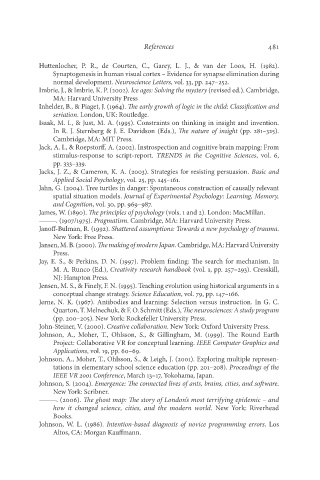Page 498 - Deep Learning
P. 498
References 481
Huttenlocher, P. R., de Courten, C., Garey, L. J., & van der Loos, H. (1982).
Synaptogenesis in human visual cortex – Evidence for synapse elimination during
normal development. Neuroscience Letters, vol. 33, pp. 247–252.
Imbrie, J., & Imbrie, K. P. (2002). Ice ages: Solving the mystery (revised ed.). Cambridge,
MA: Harvard University Press
Inhelder, B., & Piaget, J. (1964). The early growth of logic in the child: Classification and
seriation. London, UK: Routledge.
Isaak, M. I., & Just, M. A. (1995). Constraints on thinking in insight and invention.
In R. J. Sternberg & J. E. Davidson (Eds.), The nature of insight (pp. 281–325).
Cambridge, MA: MIT Press.
Jack, A. I., & Roepstorff, A. (2002). Instrospection and cognitive brain mapping: From
stimulus-response to script-report. TRENDS in the Cognitive Sciences, vol. 6,
pp. 333–339.
Jacks, J. Z., & Cameron, K. A. (2003). Strategies for resisting persuasion. Basic and
Applied Social Psychology, vol. 25, pp. 145–161.
Jahn, G. (2004). Tree turtles in danger: Spontaneous construction of causally relevant
spatial situation models. Journal of Experimental Psychology: Learning, Memory,
and Cognition, vol. 30, pp. 969–987.
James, W. (1890). The principles of psychology (vols. 1 and 2). London: MacMillan.
———. (1907/1975). Pragmatism. Cambridge, MA: Harvard University Press.
Janoff-Bulman, R. (1992). Shattered assumptions: Towards a new psychology of trauma.
New York: Free Press.
Jansen, M. B. (2000). The making of modern Japan. Cambridge, MA: Harvard University
Press.
Jay, E. S., & Perkins, D. N. (1997). Problem finding: The search for mechanism. In
M. A. Runco (Ed.), Creativity research handbook (vol. 1, pp. 257–293). Cresskill,
NJ: Hampton Press.
Jensen, M. S., & Finely, F. N. (1995). Teaching evolution using historical arguments in a
conceptual change strategy. Science Education, vol. 79, pp. 147–166.
Jerne, N. K. (1967). Antibodies and learning: Selection versus instruction. In G. C.
Quarton, T. Melnechuk, & F. O. Schmitt (Eds.), The neurosciences: A study program
(pp. 200–205). New York: Rockefeller University Press.
John-Steiner, V. (2000). Creative collaboration. New York: Oxford University Press.
Johnson, A., Moher, T., Ohlsson, S., & Gillingham, M. (1999). The Round Earth
Project: Collaborative VR for conceptual learning. IEEE Computer Graphics and
Applications, vol. 19, pp. 60–69.
Johnson, A., Moher, T., Ohlsson, S., & Leigh, J. (2001). Exploring multiple represen-
tations in elementary school science education (pp. 201–208). Proceedings of the
IEEE VR 2001 Conference, March 13–17, Yokohama, Japan.
Johnson, S. (2004). Emergence: The connected lives of ants, brains, cities, and software.
New York: Scribner.
———. (2006). The ghost map: The story of London’s most terrifying epidemic – and
how it changed science, cities, and the modern world. New York: Riverhead
Books.
Johnson, W. L. (1986). Intention-based diagnosis of novice programming errors. Los
Altos, CA: Morgan Kauffmann.

